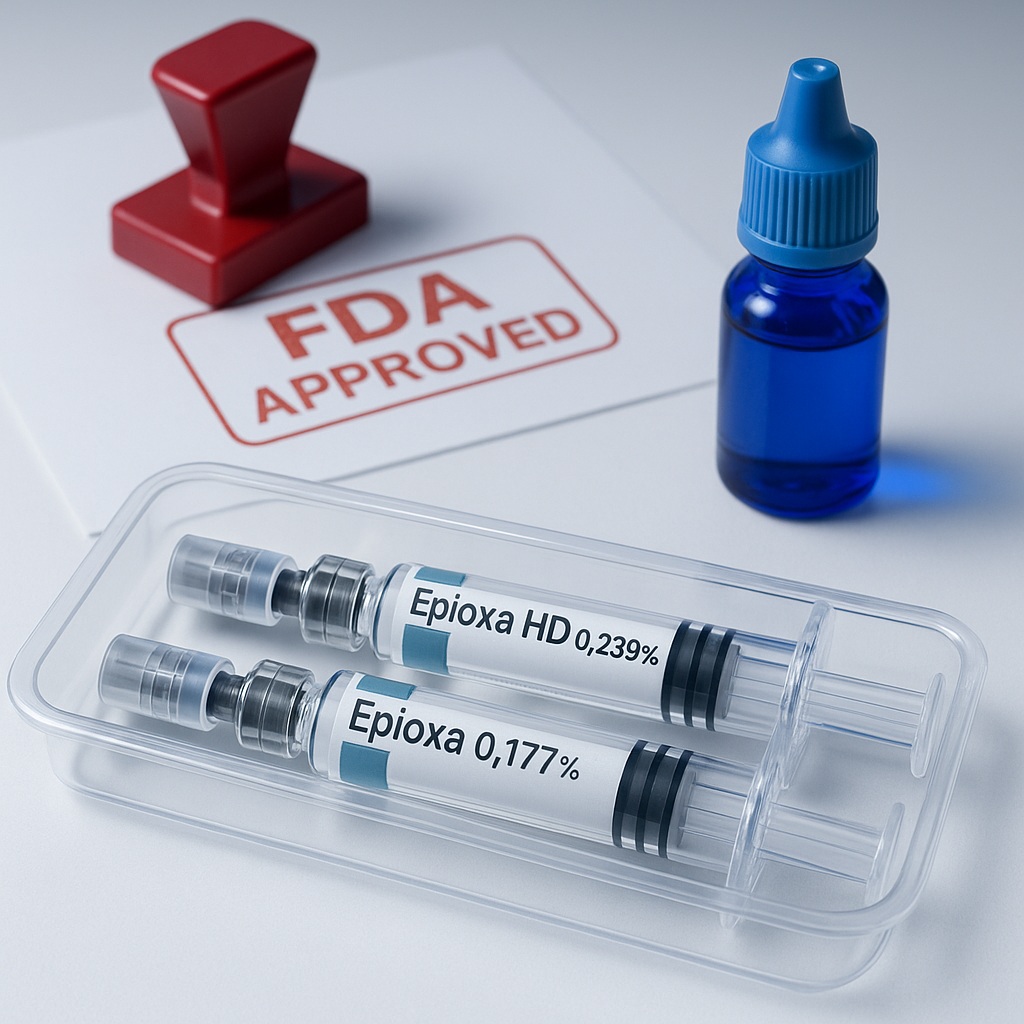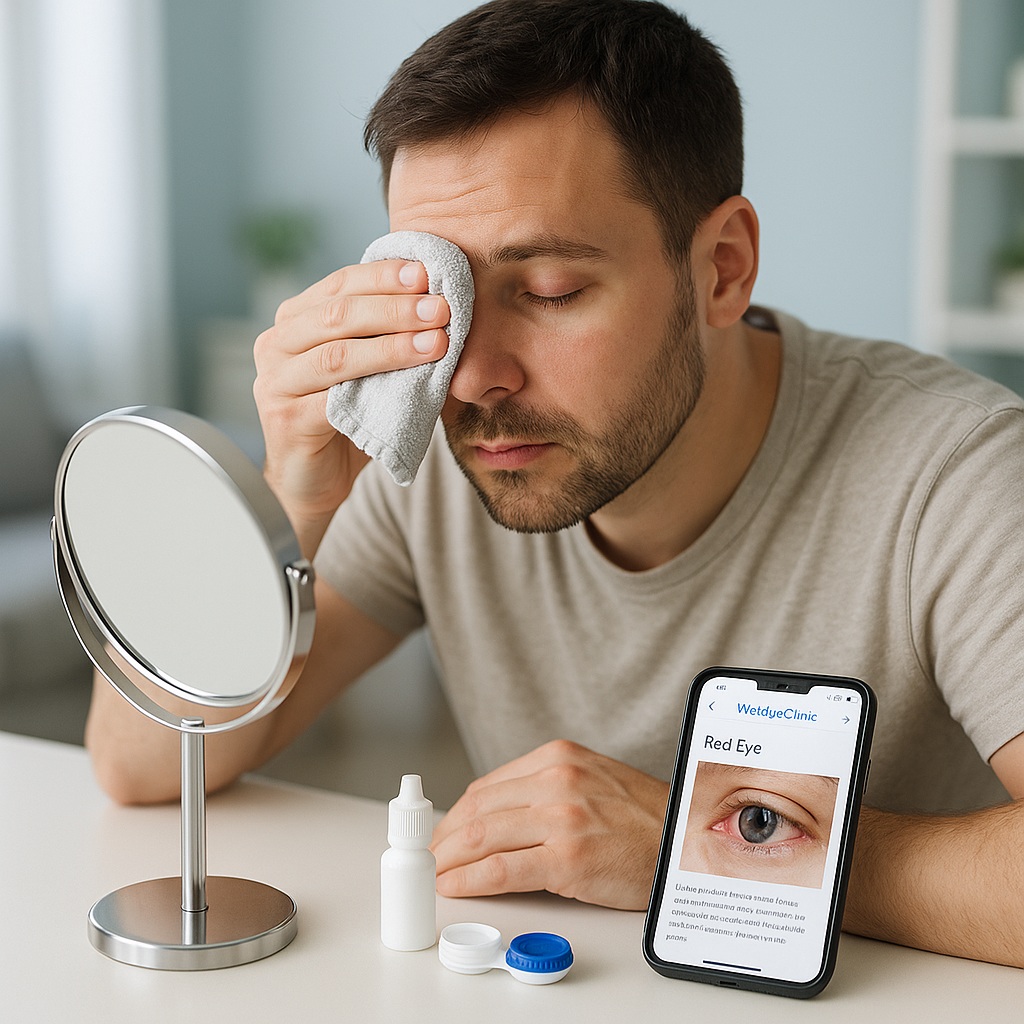Published: October 2025
Glaukos Epioxa FDA approval is a major milestone for patients with keratoconus, a progressive eye disease that makes the cornea thinner, weaker, and more cone-shaped. The U.S. Food and Drug Administration (FDA) has approved Glaukos’ Epioxa™, a new “epi-on” corneal cross-linking therapy designed to strengthen the cornea and slow or stop worsening vision. In this article, we explain what Glaukos Epioxa FDA approval means, how this new treatment works, who may qualify, safety and recovery, and when patients might realistically expect access.
What Does Glaukos Epioxa FDA Approval Mean for Patients?
Glaukos’ Epioxa is the first FDA-approved corneal cross-linking option that keeps the surface layer of the cornea (the epithelium) intact. This “epi-on” approach is different from the older “epi-off” method, where the epithelium is removed before treatment. By keeping the surface in place, the goal is to reduce pain, lower infection risk, and help patients heal faster while still stabilizing the cornea. For many people with progressive keratoconus, this may mean an earlier, more comfortable intervention before the disease becomes severe.
What Is Keratoconus?
Keratoconus is a condition where the cornea (the clear front “window” of the eye) becomes thin and bulges forward into a cone shape. This can distort vision, cause increasing astigmatism, and make glasses or contact lenses less effective over time. Keratoconus often appears in the teenage years or early adulthood and can continue to worsen through the 20s and 30s. Without treatment, some patients eventually need a corneal transplant. The goal of cross-linking treatments like Epioxa is to stiffen the cornea and keep the condition from getting worse.
How Does Epioxa Work?
Epioxa uses special riboflavin (vitamin B2) eye drops combined with controlled UV-A light to create extra “cross-links” inside the cornea. These cross-links act like reinforcements, making the cornea stronger and more stable. The key difference with Epioxa is that it is performed without removing the epithelium (“epi-on”). In older, traditional cross-linking (“epi-off”), doctors gently removed that protective surface first. Epioxa is designed so the medicine still penetrates deeply enough to work, while keeping the surface layer in place for comfort and protection.
How Is Epioxa Different From Traditional Cross-Linking?
Traditional FDA-approved corneal cross-linking in the U.S. has required removing the epithelium. That method works, but it often causes several days of significant pain, light sensitivity, tearing, and blurred vision. Patients usually wear a bandage contact lens while the surface heals. By contrast, the goal of Epioxa’s epi-on technique is:
- Less pain: Because the surface layer stays on the eye, irritation is expected to be milder.
- Lower infection risk: An intact surface helps protect the cornea from germs.
- Faster comfort recovery: Many patients may return to normal activities sooner than with epi-off cross-linking.
- Vision preservation: Just like traditional cross-linking, the goal is to slow or stop keratoconus from progressing so that patients can keep wearing glasses or contact lenses instead of needing a transplant later.
Who Is a Good Candidate for Epioxa?
Doctors typically consider cross-linking when keratoconus is progressing — meaning the cornea is continuing to thin or steepen, or vision is getting worse even with updated glasses or contact lenses. Candidates may include:
- Teenagers and young adults with documented progression who want to protect their vision early.
- Patients in their 20s or 30s who still want to avoid corneal transplant.
- People who are struggling to keep good vision even with custom contact lenses.
Not every cornea is the same. Your corneal thickness, existing scarring, and overall eye health will decide if Epioxa is appropriate. You should see a cornea specialist or keratoconus clinic for measurements and mapping of your cornea.
What Happens During the Procedure?
On treatment day, numbing drops are placed in the eye. The riboflavin drops are applied following the Epioxa protocol, then a precisely controlled UV-A light source is used. This light + riboflavin interaction creates new structural bonds in the cornea. Most patients go home the same day. Your eye doctor may place a temporary bandage contact lens and prescribe medicated drops to support healing and reduce inflammation.
Recovery, Pain, and Safety
Because Epioxa is epi-on, recovery is expected to be gentler than older epi-off cross-linking. Patients may still notice temporary light sensitivity, redness, tearing, gritty sensation, or blurred vision for a few days. Serious side effects such as infection or corneal haze are possible with any cross-linking procedure, but keeping the epithelium in place may help lower those risks. You will have follow-up visits so the doctor can confirm that the cornea is healing and that the shape of the cornea is stabilizing.
Cost, Insurance, and Availability
Insurance in the U.S. often covers cross-linking when there is documented progressive keratoconus. Coverage for Epioxa will likely follow similar rules, but each insurer can differ. Ask your clinic’s billing team to check whether prior authorization is required. After Glaukos Epioxa FDA approval, the company must still finalize rollout, train surgeons, and distribute the system. That means availability may start at specialty cornea centers first and then expand.
How Is This Different From Glaukos iDose for Glaucoma?
You may also see Glaukos mentioned in glaucoma news. Glaukos developed iDose, a tiny drug implant placed inside the eye to lower pressure in adults with open-angle glaucoma. That is completely different from keratoconus. Epioxa is for the cornea, not eye pressure. iDose is about treating glaucoma long-term. Epioxa is about stabilizing the cornea in keratoconus so vision doesn’t keep getting worse.
Bottom Line
Glaukos Epioxa FDA approval represents the first FDA-cleared “epi-on” cross-linking treatment for keratoconus. The goal is to deliver the same vision-saving stability of corneal cross-linking with less pain, faster comfort recovery, and a lower infection risk than traditional epi-off methods. If you or your child has progressive keratoconus, ask a cornea specialist whether you are a candidate, how soon Epioxa will be available in your area, and what insurance may cover.


